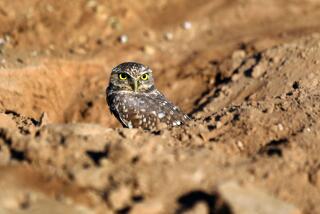Wildlife Researchers Follow Hoots of the Great Gray Owl
- Share via
BUTTE FALLS, Ore. — The owl’s soft, deep calls float through the trees, the only sound in the cold, predawn twilight.
Susan Catton and Jim Goode scan the timber looking for the bulky silhouette of the only bird that could voice those telltale hoots. But the moon’s thin light reveals no great gray owls in the treetops.
“He’s moving on us,” whispers Catton.
This spring, Catton and Goode will spend at least one morning a week in the woods, looking for great gray owls for the U.S. Forest Service. Like dozens of wildlife biologists and natural resource specialists in Oregon and Washington, they are implementing the details of the Northwest Forest Plan.
The forest plan emerged in 1994 after concerns about the survival of the northern spotted owl forced dramatic logging reductions in federal forests. Now researchers are gathering information on more old-growth-dependent plants and animals, including the great gray owl, hoping to avoid the bitter political fighting that marked the spotted owl’s listing as an endangered species.
“What we’re all about is managing habitat,” says Catton, a wildlife biologist for the Rogue River National Forest. “We’re learning what we have here and what we need to do to keep them here.”
Catton says collecting data about the forest plants and animals is the first step toward the “ecosystem management” concept that is the heart of the Northwest Forest Plan. Under ecosystem management, foresters’ goal is to protect and enhance general forest health rather than produce large quantities of any single commodity (such as timber) at the expense of other forest values such as clean water or wildlife diversity.
The great gray is neither threatened nor endangered under federal laws. But it is a rare bird because it is a predator at the top of its food chain. And it occupies significantly different old-growth habitat from the spotted owl, making it a useful species for evaluating forest health, says Steve Godwin, a wildlife biologist for the Medford District of the Bureau of Land Management.
“We’re trying to assess the population,” says Godwin, “to make sure we’re not sending [the great gray] toward the endangered species list and locking up more land.”
Like the Forest Service, the Bureau of Land Management is surveying its forests for great gray owls. Scientists chose to study the great gray because they knew little about North America’s largest owl, except that it nested in old-growth trees and ranged as far south as the Sierra Nevada.
For the past two years, biologists have cruised southern Oregon forest trails and roads during the great grays’ nesting season, broadcasting recordings of their calls and listening for responses. When observers hear hoots, researchers return to the site to look for the birds and locate their nest trees.
Two years’ data isn’t enough to make sound estimates about the great grays’ population in Southern Oregon, but Godwin said the surveys have shown that there are more of the birds in Southern Oregon than people originally thought. Owls have been heard or seen at 80 locations on 15,000 acres of BLM lands, an area of nearly 24 square miles.
The surveys also indicate that great grays nest in smaller, low-elevation trees as well as the high-mountain, old-growth timber that scientists believed was their preferred habitat.
Finding the birds has been much more difficult than locating spotted owls, which show little fear of humans and respond to calls and baits. Great grays, by comparison, are aloof, secretive and shy.
“You hear them at night and go back during the day to locate them and you can’t,” says Godwin.
“You have to be pretty close to them just to get them to respond,” says Goode, a natural resource specialist for the Rogue River National Forest. “Their response [to calls] is fairly quiet. If there’s any wind or you’re by a stream, you might not hear them.”
“They take flight pretty readily,” says Catton, “if they feel you’re a threat.”
The Northwest Forest Plan includes strategies for protecting and preserving plants and animals that thrive in old-growth timber. Great-gray-owl nests, for example, must be surrounded by a quarter-mile no-cutting circle. At the other extreme, for some species of mushrooms, the Forest Service and BLM must do no more than conduct general regional surveys to determine the mushrooms’ range.
Catton says that after several more years of surveying, forest managers should have a better sense of the owl’s numbers in Southern Oregon. Then they can begin to know whether its numbers are increasing or declining, and design activities such as timber sales to maintain or improve habitat.
Catton says just seeing a great gray on the wing can be a thrill.
“What’s most impressive to me is to see them flying through the [forest] canopy,” she says. “It’s like a 747. They have these huge wings, but you don’t hear them.”
More to Read
Sign up for Essential California
The most important California stories and recommendations in your inbox every morning.
You may occasionally receive promotional content from the Los Angeles Times.









